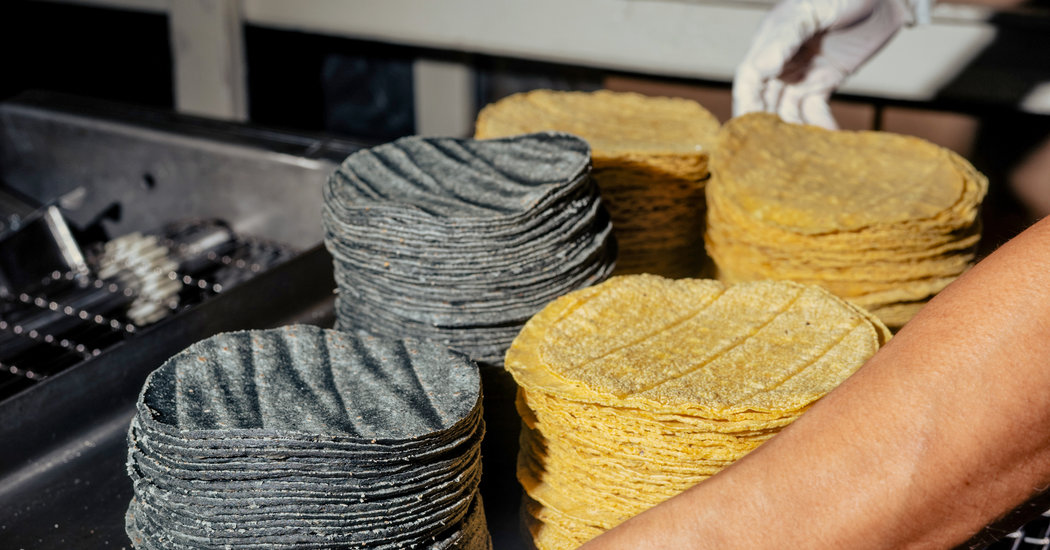
LOS ANGELES — When Ricardo Ortega wants to convince someone of the unparalleled deliciousness of nixtamalized corn, he hands them a hot tortilla right off his clanking production line in the Boyle Heights neighborhood of Los Angeles.
Late at night, as the ovens exhale the comforting smell of masa, a single, plain tortilla can be very persuasive: roughly textured, but dewy and tender, with a sweet, almost toasted flavor.
“We’re dealing with an uncompromised tortilla,” Mr. Ortega said. “It should have just three ingredients: corn, cal and water.”
The process of nixtamalization starts with heating and soaking dried corn with cal, or calcium hydroxide (also known as slaked lime), and grinding it into nixtamal. It involves time and labor. But the industrialization of tortillas that began in the 1980s and made them ubiquitous in supermarkets changed that, and put thousands of tortillerias out of business. Most store-bought tortillas are made from Maseca, a leading brand of corn flour, stabilized with gums and preservatives.
“Even my mom’s fridge is nothing but Guerrero,” said Mr. Ortega, referring to the household brand owned by Gruma, the largest tortilla manufacturer in the world.
Three nights a week, working in a small factory they began leasing last year, Mr. Ortega and his business partner, Ommar Ahmed, produce about 15,000 tortillas per evening the old-fashioned way. They call their business Kernel of Truth Organics, and along with a handful of regional producers, such as Three Sisters Nixtamal in Portland, Ore., and Tortilleria Nixtamal in New York, they are building on a movement to get traditionally made tortillas back into homes and restaurant kitchens.
In Mexico, small tortilla-makers have responded to a national drop in consumption, as well as quality, by devoting themselves to the craft, urging home cooks to prize the tortilla dough, or masa, made from nixtamal, and persuading more farmers to grow heirloom corn varieties.
In Los Angeles, producers such as La Princesita and Acapulco Mexicatessen sell traditional corn tortillas and bags of fresh masa directly to consumers, out of their small factories. Mr. Ortega and Mr. Ahmed wanted to do the same, but they also wanted to compete with the big supermarket brands.
“Going back to nixtamal is beautiful,” Mr. Ortega said. “But our main mission is to make these tortillas accessible to everybody.”
Mr. Ortega and Mr. Ahmed, both 33, started making tortillas in 2014 in a narrow kitchen space in Boyle Heights. Once they learned the basics, through trial and error, they courted local chefs with their fresh tortillas.
“Chefs don’t get sold on catchy words or marketing, so the tortilla has to stand on its own,” Mr. Ortega said.
But in Los Angeles, where small tortillerias are fiercely competitive, and the radio station KCRW hosts an annual tournament in which more than 60 vendors compete, buyers tend to be loyal to long-established businesses. Mr. Ortega and Mr. Ahmed were new to the game. They had to prove themselves.
As millions of home cooks who make their own tortillas daily already know, the craft seems simple, but every tortilla is shaped by an infinite number of variables.
Masa can be moody, never exactly the same two nights in a row. If kept warm for too long, the dough can sour. If kept cold for too long, it can dry out and crumble. Press it too gently, and the tortilla is fat. But overcook it, and even a pudgy tortilla can lose its tenderness.
Mr. Ortega and Mr. Ahmed took early versions of their tortillas to the chef Wesley Avila, of Guerrilla Tacos, an experimental taqueria in Downtown Los Angeles that is just as likely to pile a tortilla with breakfast sausage as with sea urchin. But Mr. Avila said their tortillas were too thin and too dry for his purposes. So the duo got to work, tinkering.
They added hours to the initial soaking period, letting the corn puff up with more water, drawing out the kernels’ flavor. To keep the tortilla from ripping under the weight of taco toppings, they adjusted the roller and cutter of the machine to produce a thicker disc.
After several rounds of edits, Mr. Avila got precisely the tortilla he was looking for, and in 2016 Mr. Ortega and Mr. Ahmed landed Guerrilla Tacos as their first high-profile restaurant client.
Now, a typical night at their tortilleria starts at 9 p.m. with vats of corn that need to be warmed and soaked.
Though most of the yellow and blue corn that Kernel of Truth processes is grown in the United States, the company buys some varieties of heirloom corn grown in Mexico, through the Mexican purveyor Tamoa. They have been experimenting lately with a pink-colored variety from Michoacán — Mr. Ortega compares the flavor to that of roasted almonds.
Soaked corn is ground between wheels of heavy volcanic rock, much like the basalt rocks used by the Mesoamerican cooks who first mastered the process. The result is a squishy, slightly sticky dough, which is rolled, cut and par-baked as it moves through the production line.
Mr. Ortega and Mr. Ahmed do a lot of the work themselves, with help from two workers at the end of the line, who blast cumbia, a rhythmic folk music, as they pack the fresh tortillas in stacks. These tortillas are ready to be delivered early in the morning to HomeState, a Texan restaurant with three locations in Los Angeles, and Guelaguetza, a Oaxacan restaurant in Koreatown, along with many others.
But Mr. Ortega and Mr. Ahmed say they want to grow their business beyond restaurants, so they can bring their prices down and see their tortillas stocked in supermarket shelves all over the city, right next to Guerrero’s.
“If I want my mom to use them,” said Mr. Ortega, letting out a sigh, “they have to be more accessible.”



